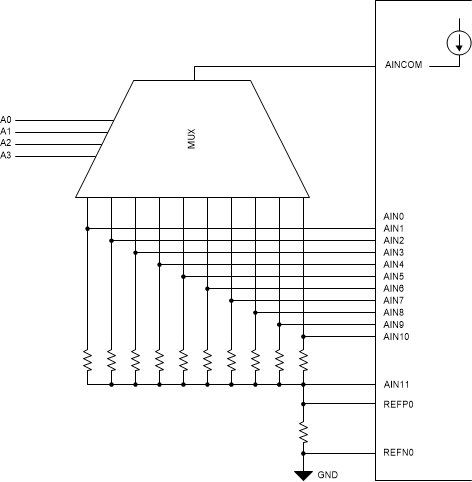Other Parts Discussed in Thread: ADS1148
Hello,
In a recent design, we migrated from the ADS1148 connected to 7 RTDs to the ADS114S08 so that we could measure 10 RTDs. To utilize so many channels on these chips you have to use the same pin for the + PGA input as the excitation current in a two-wire configuration for each RTD. Below is how we're wired for one of the RTDs:
This worked well with the ADS1148, and the temp measurements were reasonably accurate. When we try this with the ADS114S08 (no filter resistors), the temp measurements are high by 10-15 degC. After some playing around with a fixed resistor in place of the RTD and measuring voltages with a DMM and comparing that to the ADC digital output, it became clear that there must be resistance (switch resistance?) on the order of 50 ohms inside the chip between the output pin and the MUXs that connect the PGA+ and the iDAC to that pin. To prove this, I wired a different external pin to the pin that is connected to the PGA+ pin and routed the current source through that, so that the IDAC current exits the chip first and then flows across the RTD with dedicated pins across it for the PGA+ and PGA- connections. This fixes the problem, and must be because now that 50hm resistance in series with the current source doesn't matter because the PGA+ pin is connected on the other side of it - after it has exited the chip.
I guess my question is, can you confirm that there's that much series resistance (~50 ohms) to the output pins, and that the ADS114S08 should not be used in a two-wire configuration where the same pin is used for both the PGA+ input and the excitation current? None of the application notes have this part connected like this, and maybe that's a clue. In the design note sbaa329, the #2 design note on page 2 says not to have the ADC input pin be the same pin as the excitation current, but it blames the filter resistors as the reason not to do it. But we don't have filter resistors in our design.
This is disappointing because it means that the max number of RTDs you can connect and get a reasonable measurement on is 6 because you need an extra pin for the excitation current for each RTD you're measuring. And I'm not comfortable calibrating that large error out because that (switch?) resistance will change over temperature and add to the error. (When I put my finger on the ADS114S08, I can cause a small drift in the temperature measurement when we use the same pin for PGA+ and excitation current. When they are separate pins, no visible drift in temp reading happens when I put my finger on the chip.)
Please let me know if my conclusion is correct, or if you think I just may have a bad part. Thank you!
Phil


